Word Accessibility
Alt text, Images, and Links
Include text alternatives for visual elements such as images and use hyperlinks in place of bare URLs.
On this page:
Text Equivalents
As discussed in the alternative text chapter of this guide, visual information needs a text equivalent. In Word, the text equivalent of visual information can be included in:
- Text adjacent to an image. Presenting text with visuals that reinforce and support one another is a great practice and ensures everyone can access the information.
- Figure captions.
- The alt text field of a graphic.
Figure caption
If equivalent information is not presented in text adjacent to a graphic, add a figure caption. Figure captions are accessible to all readers of a document.
To add a figure caption to an image:
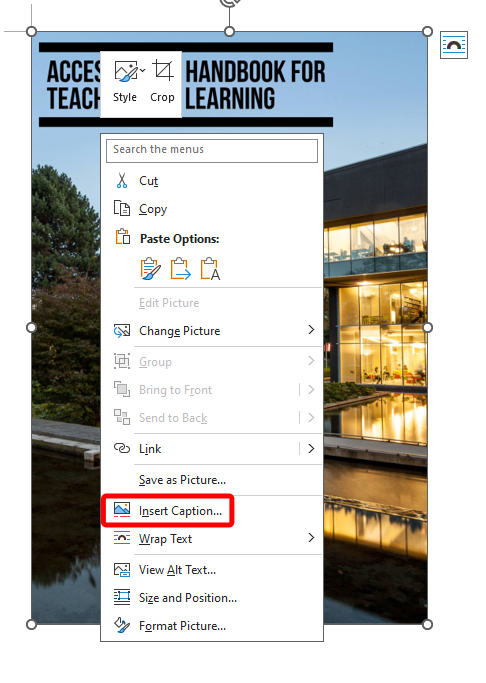
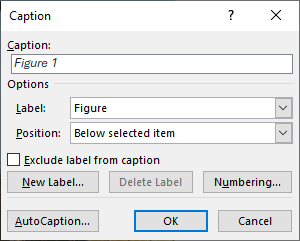
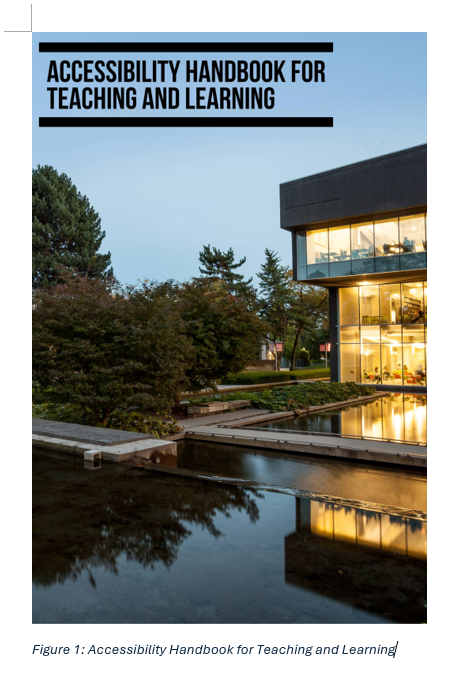 The figure caption will appear below the image. In the Alt Text pane for the image, check Mark as Decorative. Read more about how to insert a caption for a picture from Microsoft support.
The figure caption will appear below the image. In the Alt Text pane for the image, check Mark as Decorative. Read more about how to insert a caption for a picture from Microsoft support.
Alt Text
In instances where a figure caption is not preferred, use the alt text field to add a description of the information present in a graphic. The alt text field is only read by screen reader software to provide visual information in accessible format.
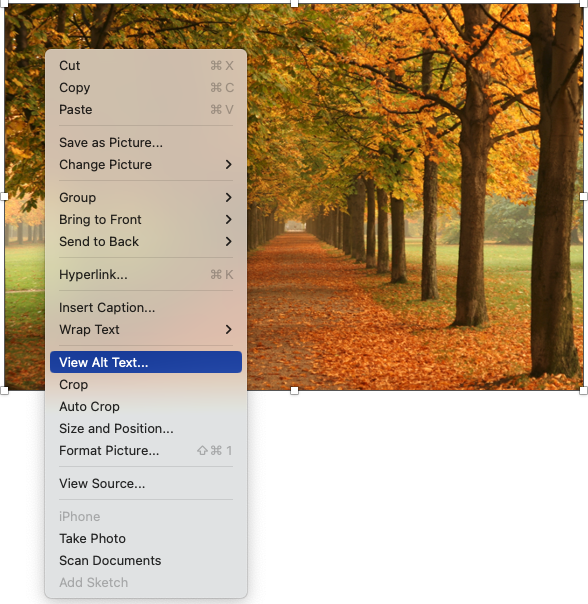 To add alt text in Office programs:
To add alt text in Office programs:
- Right click on an image and select View Alt Text…
- Enter a description in the dialogue box.
- If a graphic is purely decorative, check Mark as Decorative.
To add alt text in Office online programs:
- Select the image
- Navigate to the Picture tab
- Select Alt Text and enter your description in the Description field.
- If the image is purely decorative, leave the Description field blank.
The Office Accessibility Checker will flag images that do not have alternative text. In the Accessibility pane, Missing object description will appear as an error. Do not rely on the automatically generated alt text, it is rarely useful.
Add alternative text to simple charts but also include table data for complex charts and data sets. Best practice is to include table data adjacent to the chart, but linking to the data elsewhere in the document is also an effective method. The alt text field does not support links, but a link can be added to a figure caption. Ensure the link text explains the destination.
Grouped Shapes
A group of shapes, such as the stars in the demonstration below, must be grouped to provide meaningful alt text. To group images in Word:
- Select the first object.
- Hold Control (Command on macOS) and click on the remaining objects.
- On the Shape Format tab select Group > Group.
- Add Alt Text to the grouped shape.
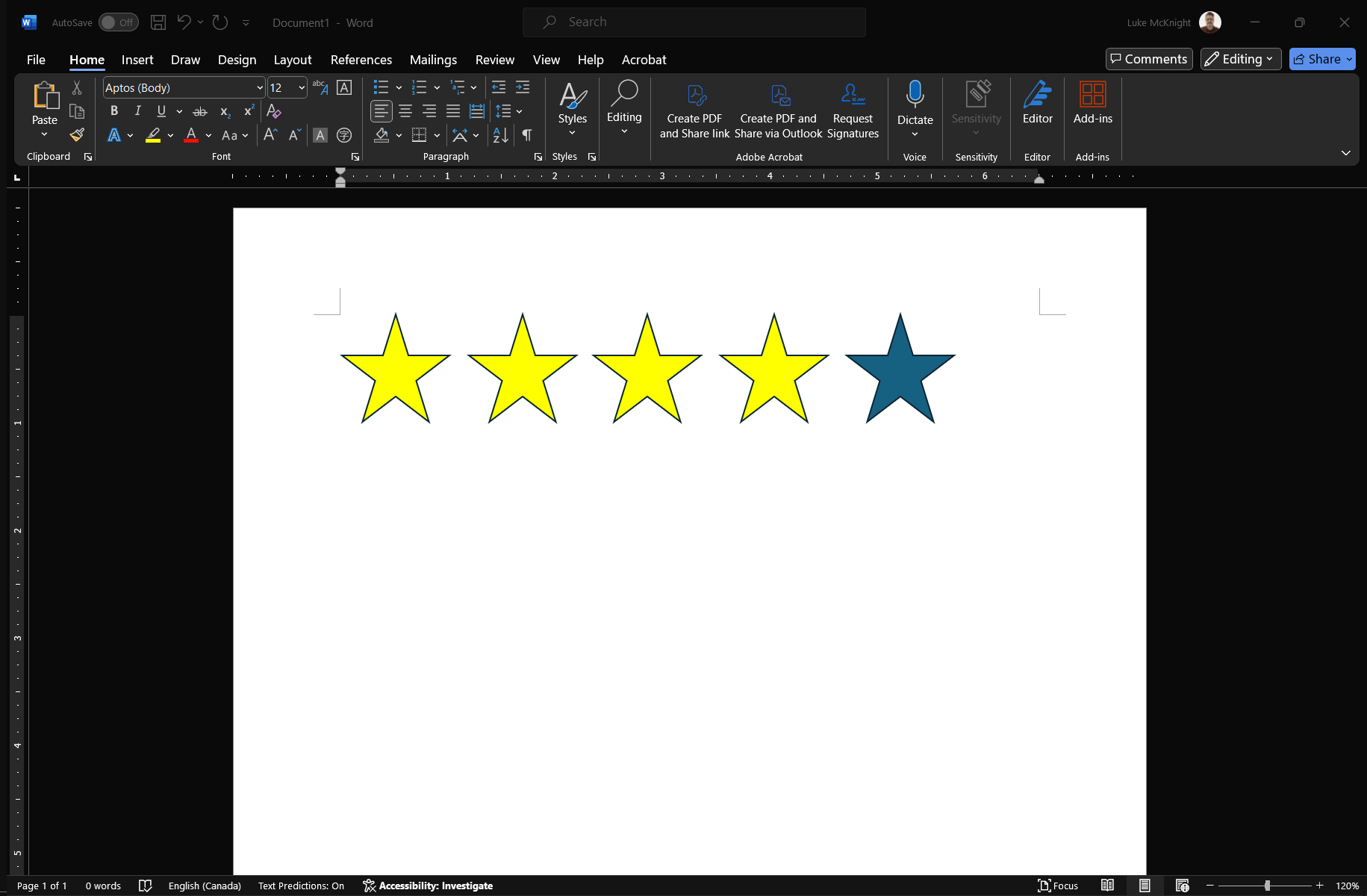
Read more about how to group or ungroup shapes, pictures, or other objects.
Review this Pressbooks’ alternative text chapter and read Microsoft guides for adding alt text to images, SmartArt, shapes, and charts and how to make Word documents accessible.
Graphs and Charts
Do not include photos of charts or graphs, insert them properly via Insert tab > Chart dropdown.
A concise and meaningful title or caption helps all readers. Add alt text to graphs and charts but also include table data for complex charts and data sets. Best practice is to include table data adjacent to the chart, but linking to the data elsewhere in the document is also an effective method. Ensure the link text explains the destination.
Do not rely on colour alone to distinguish data. Use symbols or different line styles. Include a legend.
Apply data and axis labels by selecting your graph or chart and navigating to Chart Design tab and selecting Add Chart Element dropdown.
Provide alternative formats, such as a table of data plotted via chart
- For a chart or graph, provide data in table form beside the element. If size and spacing is a concern, place the data in another sheet and provide a link near the floating element.
Visuals must use In line with text wrapping style to be accessible. Click on your image and choose Picture tab or the Layout Options button and choose In line with text. Microsoft offers detailed instructions on text wrapping.
Videos and Audio Recordings
Ensure embedded media has text equivalents. Videos must have closed captions and audio must have a transcript.
Hyperlinks
When linking to a website, document or other part of a document, use meaningful hyperlink text. Linked text should be descriptive, concise, unique and visually distinct. Do not use bare URLs. To learn more about writing link text, consult the accessible links chapter of this guide.
Use Word’s default styling of blue, underlined text for links.
To add a link in Word:
- Select the text you want to link
- Right-click and select Hyperlink or press Control (Command on macOS) and k
- Verify the Text to Display text
- Paste the destination URL in the Address box
You may have existing documents that contain bare URLs. To update existing, bare URLS to accessible links:
- Right-click on the bare URL
- Select Edit Hyperlink…
- In the Text to display field, type a brief description of link destination.
- Click Ok.
Read more about hyperlink text in Word.
Alternative text is a text equivalent of graphics in a document or webpage. Alternative text is coded to be hidden visually, but read to a screen reader user.
Assistive technology software that reads content aloud and helps blind and low vision users navigate and interact with their computers.
Information presented in a grid format of rows and columns, generally to show a relationship between sets of data
A text equivalent of audio content in a video, displayed synchronously. Closed captions are toggled on or off by viewers, as opposed to open captions that are burned into the video and always displayed.
Transcription is the process of converting audio into written text. A transcript is a written record of all audio in media. Captions are synced to the content.

